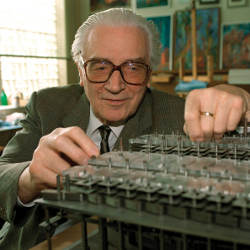
When researchers stumbled across the Zuse Z9 in the storage room of a Swiss museum two years ago, they initially did not recognize the significance of what they had found. In fact, the Z9 was unknown even to many historians of computing.
But they soon came to realize what they had uncovered: The world’s first workable program-controlled binary relay calculator using floating-point arithmetic, which was the creation of computer pioneer Konrad Zuse, whose 100th birthday they were celebrating.
A German civil engineer, Zuse had created the world’s first functional, program-controlled Turing-complete computer, the Z3, in 1941. That same year he founded one of the earliest commercial computer companies, which produced the Z4, the world’s first commercial computer. And in 1946, he designed the first high-level programming language, Plankalkül.
He founded another company, Zuse KG, in 1949 and developed the Z9 for Remington Rand Zurich and other large companies. The Z9 consisted of a processor, an input and output unit, and a rectifier, and was embedded in a group of punch card machines. The Z9 was Zuse KG’s first relay calculator manufactured in series, with delivery starting in 1953. Some 20 to 30 Z9s were manufactured.
The confusion surrounding the Z9 stems in part from the fact that Konrad Zuse describes the machine in his memoirs but never refers to it by name. According to his writings, the Z9 was able to perform all four basic arithmetic operations, among others. The calculating punch was used mostly for office work but also for engineering tasks.
However, all but one of the Z9s has apparently been destroyed, according to Herbert Bruderer, a lecturer in the department of computer science at ETH Zurich, who has written a book, Konrad Zuse And Switzerland: Who Invented The Computer?, about Konrad Zuse and other early computer pionneers and their inventions.
On June 22, 2010, Konrad Zuse’s 100th birthday, the Zurich newspaper Tages-Anzeiger published an article by Bruderer about Zuse, who had died in 1995, and the Z4. “Two days later, I got a phone call from Josef Steinmann, who lives near Lucerne, [Switzerland] who told me about the existence of the Z9 and his experience with the machine,” Bruderer recalls.
Steinmann is one of the few living Z9 users, having worked on the technical staff of Remington Rand Zurich from 1956 to 1960. “Together we started looking for other eyewitnesses,” says Bruderer. “We found five.”
One, electronic engineer Ernst Inauen, began working at Remington Rand Zurich in 1958, spending most of his time programming and maintaining the Z9. Another, electrician Max Forrer, was the technician in charge of the Z9 at a Swiss spinning and weaving company from 1956 to 1968. The machine was mostly used to keep track of the salaries of the company’s 700 employees, print invoices, manage inventory, and create sales reports.
“The Z9 was very expensive to maintain,” Forrer recalls, “and had many problems necessitating having a technician in the company.” He remembers being sent to Zurich for six months where he met Konrad Zuse, who oversaw his training.
During his search for eyewitnesses, Bruderer talked to many Remington Rand customers and to museums in Switzerland and abroad to find surviving machines.
But, to Bruderer’s surprise, the curator of the Museum für Kommunikation in Berne contacted him to say that, in 2010, it had acquired a Z9 from the Technorama, which had recently divested itself of its computer collection. The Z9 now resides in the museum’s main repository.
Zuse KG built a total of 251 computers by 1967, but suffered financial problems. It was eventually purchased by Siemens and no longer exists.
One final note adding to the mystery: The Z9 is often referred to as the M9 as a result of legal wrangling that occurred when Konrad Zuse was forced to change its name to conclude his contract with Remington Rand. Because his patents had been temporarily transferred elsewhere, the company decided to rename the device the M9, with M standing for “Mithra,” reportedly “a mysterious subsidiary of Remington Rand Zurich,” says Bruderer.




Join the Discussion (0)
Become a Member or Sign In to Post a Comment